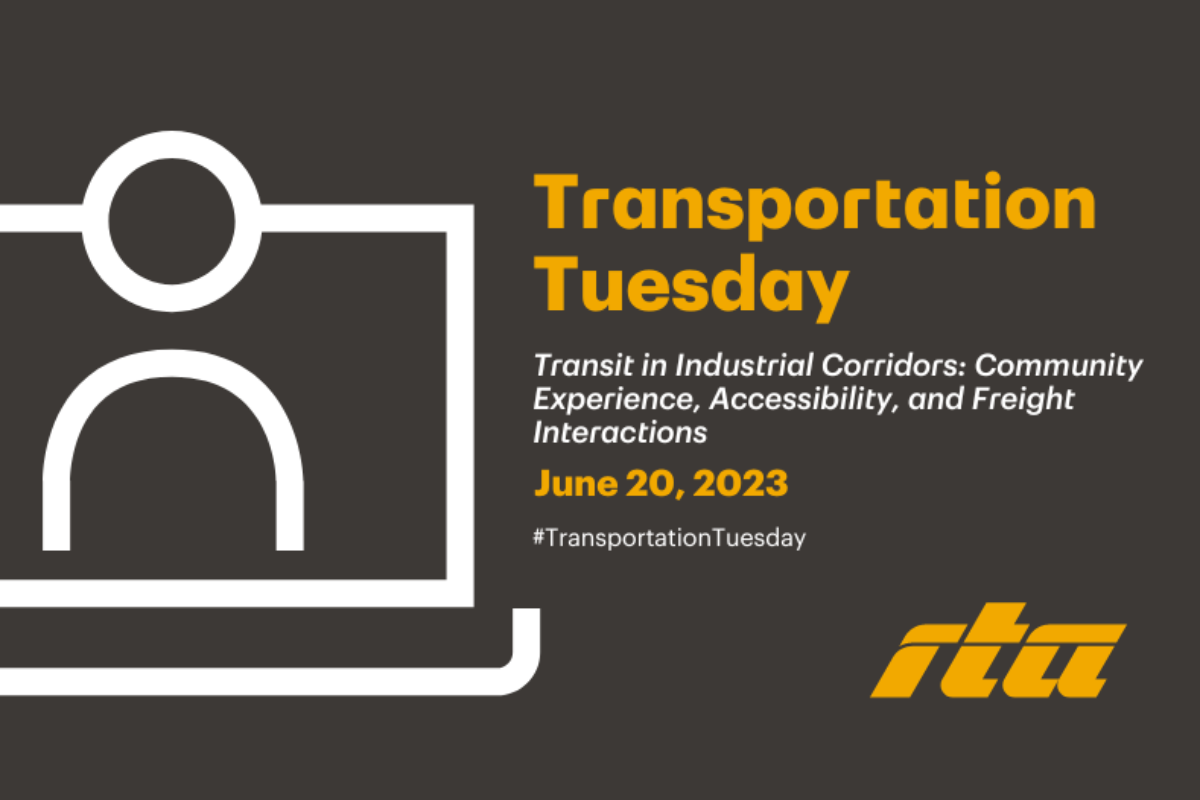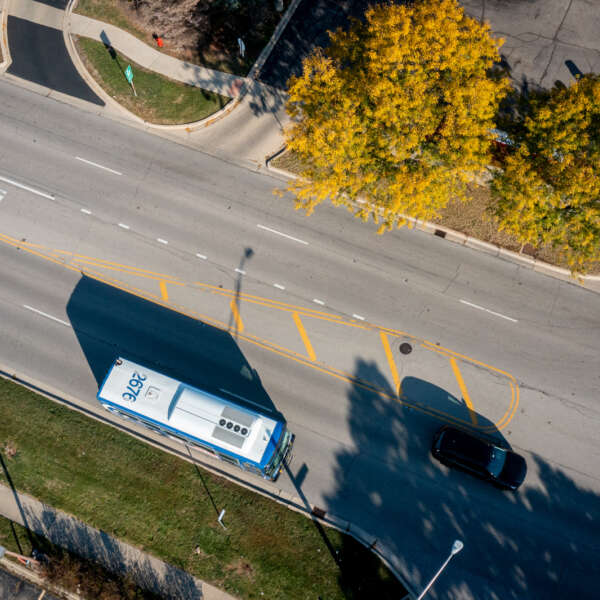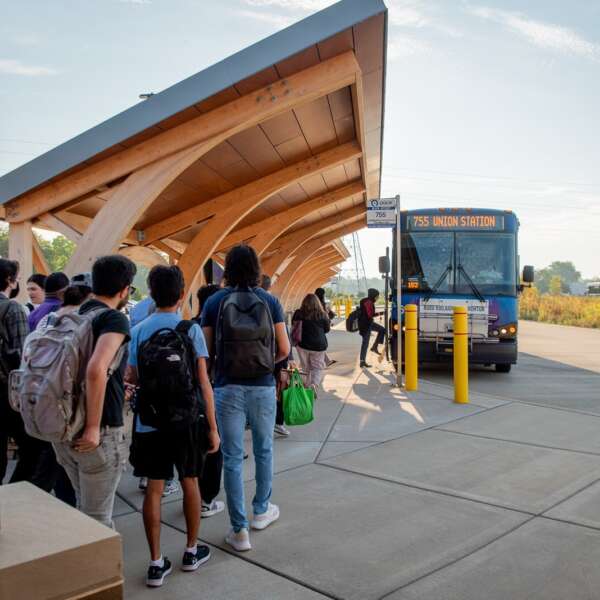Transportation Tuesday recap: Transit in Industrial Corridors: Community Experience, Accessibility, and Freight Interactions
June 21, 2023
June 21, 2023

Transit and freight movement are two quintessential aspects of Chicago’s legacy, present, and future. Industrial corridors, however, are not equitably distributed across neighborhoods. Often, people experiencing low incomes and communities of color are most exposed to negative impacts such as reduced pedestrian accessibility and increased air and noise pollution. These impacts are even more profound considering that such neighborhoods generally have a high proportion of residents who rely on transit for their daily transportation needs. At the same time, industrial corridors are major job centers that provide a benefit to the region’s economy and people employed in that sector.
This year’s penultimate Transportation Tuesday webinar explored the interactions between freight vehicles and transit from both an infrastructure and community impact perspective, featuring guest speakers from Little Village Environmental Justice Organization (LVEJO), Sam Schwartz Consulting, the Chicago Department of Transportation (CDOT), and Pace Suburban Bus.
Moderator Alex Waltz, RTA Senior Planner in the Local Planning division, moderated the roundtable discussion by presenting a series of questions before the panelists, followed by audience Q&A. The questions centered on unpacking the issues surrounding industrial corridors and the effects of freight trucks on residents and their ability to access transit services.
The panelists unanimously agreed that truck traffic is a growing concern. José Acosta-Córdova, Senior Transportation Policy Analyst for LVEJO, explained that trucks harm residents in communities adjacent to industrial land uses by emitting dangerous amounts of pollution into the air and by making it difficult to use and access public transportation due to long crossing distances and limited pedestrian facilities, both of which are common features of roadways designed to accommodate large trucks. Katherine Nickele, Transportation Planner at Sam Schwartz Consulting, elaborated that walking on sidewalks alongside main truck routes raises several safety, health, and comfort concerns for pedestrians, often discouraging them from using public transit in these neighborhoods.
David Tomzik, Planning Program Manager at Pace, said that in addition to walking, even driving in industrial corridors can be difficult because of the effects that truck traffic exerts on other road users. He explained that maneuvering around trucks can be difficult, especially for buses, making transit routes unreliable in these communities. Jeffrey Sriver, Director of Planning and Programming at CDOT, pointed out that trucks are only getting larger, longer, and heavier, creating instant negative externalities for anyone using the roads. “It is a high stress environment. Even in the best case, it diminishes the attractiveness,” said Sriver.
In exploring potential solutions to the challenges surrounding mobility in industrial corridors, roadway design was one of the strategic methods discussed by the panelists. Generally, the panelists agreed that roadways should provide more space and facilities for pedestrians, bicyclists, and transit riders, especially along transit corridors. The panelists agreed that roadway design requires making decisions about inherent trade-offs among treatments that will accommodate different road users. The panelists also noted that the current challenges facing pedestrians along industrial corridors are the result of previous decisions to design roadways with large lanes, wide turning radii, etc. to accommodate larger vehicles. The panelists also felt that Complete Streets policies could be used to help accelerate the provision of sidewalks and bikeways along industrial corridors, which could improve mobility for residents, expand travel options, and improve safety and comfort for existing bicyclists.
Nickele further explained that walking routes from transit stops to places of employment are frequently lacking sidewalks, require traversing large empty parking lots, and do not include adjacent street trees. These road design components work in concert to discourage people from taking transit, further eroding interest in using transit for transportation. As Nickele said: “Roadway design priorities determine the tradeoff of who [the street] is for. Planners need to plan how to discourage truckers and drivers from certain streets but encourage pedestrians to go on others.”
Although the bulk of the discussion was focused on general concepts and themes, a current RTA Community Planning project was referenced during the webinar. Since 2021, the RTA has been assisting CDOT to determine a course of action for improving mobility along 31st Street from Sacramento Avenue to the city limits in Little Village. This corridor is subject to high volumes of truck travel and is served by CTA Bus Route 35. Acosta-Córdova said that the data of travel trends and traveler demographics in this study area determined that industrial corridors most impact people of color and low-income communities. He stated that because roadway design tends to prioritize trucks and shipment facilities over pedestrians, there are very few residents in the area wanting to walk, bicycle, and/or use public transportation. “Our communities are overwhelmed with truck traffic and issues that come with it,” said Córdova.
The panelists noted that there is no “silver-bullet" to solve existing challenges in industrial corridors, but through the collaboration of local planners and elected officials at all levels, streets could be redeveloped to be safer and more walkable to further prioritize pedestrians and increase the use of public transportation.
“It is important to develop clean corridors and encourage the area to prepare on how to develop to support transit,” said Tomzik.
Transportation Tuesday takes place every Tuesday in June. The webinars are free, but registration is required. Learn more about future events and register to attend here.
Subscribe to our Newsletter
Related Articles
 Coalition members provide feedback on ‘Transforming Transit,’ RTA’s vision for improved service and accountability
Coalition members provide feedback on ‘Transforming Transit,’ RTA’s vision for improved service and accountability
Nearly 200 riders, advocates, and other stakeholders met virtually with the RTA on February 11 for the sixth quarterly Transit is the Answer Coalition meetin...
February 20, 2025 Far South Halsted Corridor Study prepares for future Pace Pulse service
Far South Halsted Corridor Study prepares for future Pace Pulse service
An RTA Community Planning project kicked off in late 2023 as a crucial step in bringing Pace Pulse service to Chicago’s south suburbs. The Far South Halsted ...
February 19, 2025 RTA proposes reforms to prioritize capital projects, maximizing impact of funding
RTA proposes reforms to prioritize capital projects, maximizing impact of funding
RTA is proposing a historic restructuring of the region’s transit governance to maximize the impact of new operating funding and ensure all riders experience...
February 5, 2025 RTA proposes reforms to integrate fares, require accountability for faster and more reliable transit
RTA proposes reforms to integrate fares, require accountability for faster and more reliable transit
RTA is proposing a historic restructuring of the region’s transit governance to maximize the impact of any new operating funding and ensure all riders experi...
February 5, 2025 For the third year in a row, regional transit ridership was up by double-digits in 2024
For the third year in a row, regional transit ridership was up by double-digits in 2024
Ridership across the Chicago region’s transit system continued to increase throughout 2024, according to the latest data from CTA, Metra, and Pace. The regio...
January 28, 2025 RTA is seeking $1.5 billion in annual operating funding. What would that mean for your commute?
RTA is seeking $1.5 billion in annual operating funding. What would that mean for your commute?
On January 15, RTA released Transforming Transit, a vision for the regional transit system with $1.5 billion in annual operating funding supported by a stron...
January 28, 2025